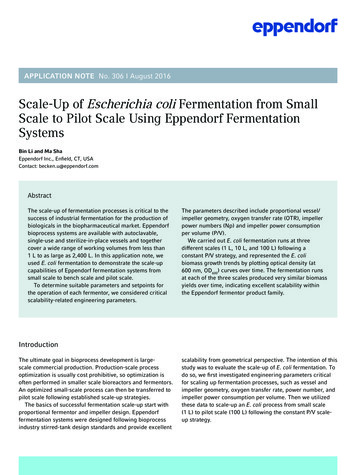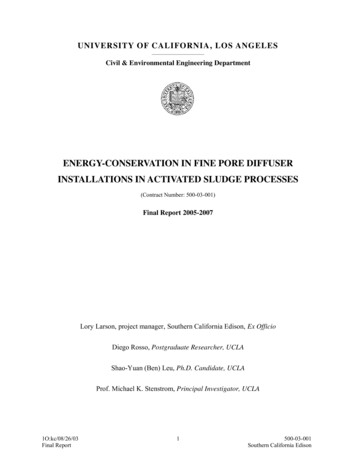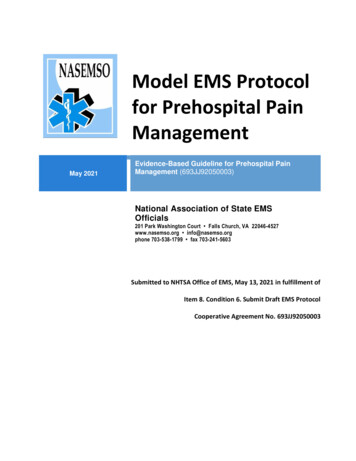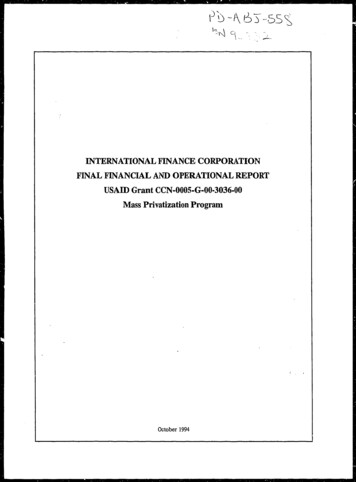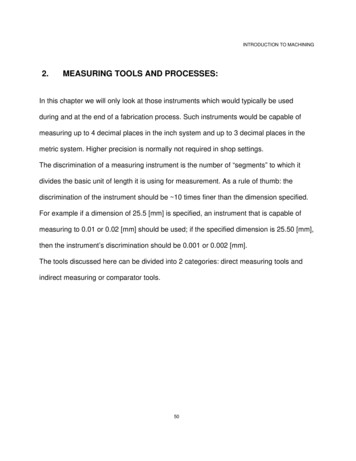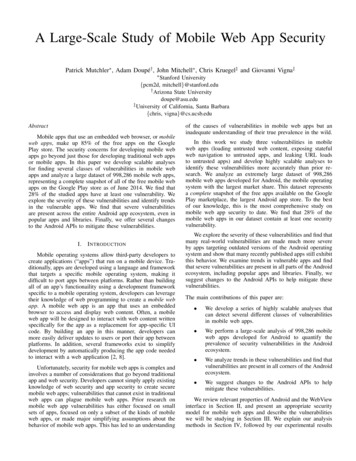
Transcription
A Large-Scale Study of Mobile Web App SecurityPatrick Mutchler , Adam Doupé† , John Mitchell , Chris Kruegel‡ and Giovanni Vigna‡ StanfordUniversity{pcm2d, mitchell}@stanford.edu† Arizona State Universitydoupe@asu.edu‡ University of California, Santa Barbara{chris, vigna}@cs.ucsb.eduAbstractMobile apps that use an embedded web browser, or mobileweb apps, make up 85% of the free apps on the GooglePlay store. The security concerns for developing mobile webapps go beyond just those for developing traditional web appsor mobile apps. In this paper we develop scalable analysesfor finding several classes of vulnerabilities in mobile webapps and analyze a large dataset of 998,286 mobile web apps,representing a complete snapshot of all of the free mobile webapps on the Google Play store as of June 2014. We find that28% of the studied apps have at least one vulnerability. Weexplore the severity of these vulnerabilities and identify trendsin the vulnerable apps. We find that severe vulnerabilitiesare present across the entire Android app ecosystem, even inpopular apps and libraries. Finally, we offer several changesto the Android APIs to mitigate these vulnerabilities.I.I NTRODUCTIONMobile operating systems allow third-party developers tocreate applications (“apps”) that run on a mobile device. Traditionally, apps are developed using a language and frameworkthat targets a specific mobile operating system, making itdifficult to port apps between platforms. Rather than buildingall of an app’s functionaility using a development frameworkspecific to a mobile operating system, developers can leveragetheir knowledge of web programming to create a mobile webapp. A mobile web app is an app that uses an embeddedbrowser to access and display web content. Often, a mobileweb app will be designed to interact with web content writtenspecifically for the app as a replacement for app-specific UIcode. By building an app in this manner, developers canmore easily deliver updates to users or port their app betweenplatforms. In addition, several frameworks exist to simplifydevelopment by automatically producing the app code neededto interact with a web application [2, 8].Unfortunately, security for mobile web apps is complex andinvolves a number of considerations that go beyond traditionalapp and web security. Developers cannot simply apply existingknowledge of web security and app security to create securemobile web apps; vulnerabilities that cannot exist in traditionalweb apps can plague mobile web apps. Prior research onmobile web app vulnerabilities has either focused on smallsets of apps, focused on only a subset of the kinds of mobileweb apps, or made major simplifying assumptions about thebehavior of mobile web apps. This has led to an understandingof the causes of vulnerabilities in mobile web apps but aninadequate understanding of their true prevalence in the wild.In this work we study three vulnerabilities in mobileweb apps (loading untrusted web content, exposing statefulweb navigation to untrusted apps, and leaking URL loadsto untrusted apps) and develop highly scalable analyses toidentify these vulnerabilities more accurately than prior research. We analyze an extremely large dataset of 998,286mobile web apps developed for Android, the mobile operatingsystem with the largest market share. This dataset representsa complete snapshot of the free apps available on the GooglePlay marketplace, the largest Android app store. To the bestof our knowledge, this is the most comprehensive study onmobile web app security to date. We find that 28% of themobile web apps in our dataset contain at least one securityvulnerability.We explore the severity of these vulnerabilities and find thatmany real-world vulnerabilities are made much more severeby apps targeting outdated versions of the Android operatingsystem and show that many recently published apps still exhibitthis behavior. We examine trends in vulnerable apps and findthat severe vulnerabilities are present in all parts of the Androidecosystem, including popular apps and libraries. Finally, wesuggest changes to the Android APIs to help mitigate thesevulnerabilities.The main contributions of this paper are: We develop a series of highly scalable analyses thatcan detect several different classes of vulnerabilitiesin mobile web apps. We perform a large-scale analysis of 998,286 mobileweb apps developed for Android to quantify theprevalence of security vulnerabilities in the Androidecosystem. We analyze trends in these vulnerabilities and find thatvulnerabilities are present in all corners of the Androidecosystem. We suggest changes to the Android APIs to helpmitigate these vulnerabilities.We review relevant properties of Android and the WebViewinterface in Section II, and present an appropriate securitymodel for mobile web apps and describe the vulnerabilitieswe will be studying in Section III. We explain our analysismethods in Section IV, followed by our experimental results
in Section V. Related work and conclusions are in sections VIand VII, respectively.II.BACKGROUNDBefore we can understand the possible vulnerabilities inmobile web apps we must first understand their structure. Notethat for the remainder of this paper we will only examinemobile web apps written for the Android platform. However,mobile web apps are in no way unique to Android. iOS andWindows Phone 8 apps have similar functionality1 .Android allows apps to embed a custom webkit browser,called a WebView. WebViews can render web content obtained either from the Internet or loaded from files storedon the mobile device. Apps load specific content in theWebView by calling the methods loadUrl, loadData,loadDataWithBaseUrl, or postUrl and passing eitherstrings containing HTML content or URLs as parameters.URLs can either be for Internet resources or for resourcesstored locally on the mobile device. We call methods usedto navigate the WebView to web content navigation methods.Users can interact with the rendered content just like theywould in a web browser. We call any app that includesembedded web content a mobile web app.While developers can create a mobile web app simply bycreating a WebView element and directing it to their webbackend, several frameworks exist to simplify development byproducing all of the code necessary to load web content packaged with an app. These apps, which we call “PhoneGap apps”based on the most popular of these frameworks, represent asubset of all mobile web apps with the unique feature that theyonly retrieve web content stored locally on the device ratherthan interacting with a remote webserver. For the purposes ofthis study we treat PhoneGap apps as a subcategory of mobileweb apps rather than singling out their unique structure.A. Inter-App CommunicationSome vulnerabilities in mobile web apps involve interapp communication. Apps primarily communicate with theAndroid operating system and other apps using an API forinter-process communication called Intents. When sending anIntent, apps specify either a specific app component to receivethe Intent or that the Intent is a general action. Example actionsinclude sending an email, performing a web search, or taking apicture. Intents that specify a specific app component are calledExplicit Intents and are delivered only to the specified appcomponent. Intents that specify an action are called ImplicitIntents and are delivered to any app component that can handlethat action. Apps declare the set of actions that each of theircomponents can handle in their Manifest (an XML documentpackaged with the app) by declaring an Intent Filter for eachcomponent. Apps can also declare that a component can handlerequests to view a particular resource by defining a customURL pattern. A thorough examination of Intents can be foundin [16].Listing 1 shows part of a manifest for a simple app thatcontains two components. The first component responds to the1 Bothplatforms have a class that behaves similarly to the WebView classin Android. In iOS it is called a UIWebView and in Windows Phone 8 it iscalled a WebView. activity android:name "SMSHandler" intent-filter action android:name "android.provider.Telephony.SMS RECEIVED"/ /intent-filter /activity activity android:name "WebHandler" intent-filter action android:name "android.intent.action.VIEW"/ data android:scheme "http"/ data android:host "example.com"/ /intent-filter /activity Listing 1: A partial app manifest demonstrating intent filters. Theapp registers two components. One will respond to incoming SMSmessages and the other will respond to requests to load web pagesfrom example.comaction SMS RECEIVED, which the Android operating systemsends when there is an incoming text message. The secondcomponent responds to requests to load web URLs from hostexample.com.B. Controlling NavigationMost mobile web apps are not general purpose browsers.They are instead designed to interact with only specific webcontent. Android allows developers to intercept and prevent unsupported web resources from being loaded by implementingthe callback methods shouldOverrideUrlLoading andshouldInterceptRequest. A WebView calls shouldOverrideUrlLoading before loading a new page in atop level frame2 . A WebView calls shouldInterceptRequest before making any web request, including iframeand image loads. In both cases the app has an opportunityto prevent the resource load by returning true in the caseof shouldOverrideUrlLoading or null in the caseof shouldInterceptRequest. The default behavior ofshouldOverrideUrlLoading is to prevent a load andthe default behavior of shouldInterceptRequest is toallow a request. For the remainder of this paper we call thesemethods navigation control methods.Simply overriding a URL load prevents a WebView fromdoing anything when a user clicks a link. This is unexpectedand might harm user experience, so most apps will send anIntent to have the browser app load an overridden URL inaddition to overriding the URL load. This approach allowsapps to correctly constrain the web content loaded in theirapp without breaking links on the web. Listing 2 shows ashouldOverrideUrlLoading implementation for a mobile web app that only supports content from the example.comdomain. All other content is prevented from being loaded inthe WebView and is sent to the default web browser instead.2 This method is not called when loading pages by calling navigationmethods (i.e., when the app explicitly tells the WebView to load web content),by making POST requests, and by following redirects on Android versionsbelow 3.0.
public boolean shouldOverrideUrlLoading(WebView view, String url){String host new return false;}Intent i new Intent(Intent.ACTION ty(i);return true;}Listing 2: A shouldOverrideUrlLoading implementationthat constrains navigation to pages from example.com. Any pagefrom another domain will be loaded in the default browser app.C. JavaScript BridgeA key difference between a mobile web app and a typicalweb app is the enhanced capabilities of web content loadedin a mobile web app. Web browser are beginning to exposesome APIs to web applications (e.g., location services), but amobile web app is able to combine normal web applicationfunctionality with all of the functionality available to a mobileapp. This combination allows developers to create rich newtypes of applications that cannot exist in a typical browser.To facilitate tight communication between app code andweb content, Android includes a feature called the JavaScriptBridge. This feature allows an app to directly expose its Javaobjects to JavaScript code running within a WebView. Specifically, if an app calls addJavascriptInterface(obj,"name") on a WebView instance then JavaScript code in thatWebView can call name.foo() to cause the app to executethe Java object obj’s method foo, and return its result to theJavaScript code. We call a Java object that has been addedto the JavaScript Bridge a Bridge Object and the JavaScriptobject used to access the Bridge Object a Bridge Reference.The relationship in Android between Bridge Objects,Bridge References, and the Same Origin Policy is unintuitive.If an app creates a Bridge Object then JavaScript code fromany origin has access to a matching Bridge Reference, even ifthat content is loaded in an iframe. Bridge Objects remainavailable to web content loaded in a WebView even afternavigating to a new page. Each Bridge Reference is protectedfrom the others by Same Origin Policy but they can all callmethods on the same Bridge Object. Therefore, Bridge Objectsare tied to the WebView instance rather than isolated by SameOrigin Policy.Figure 1 shows how multiple origins can use isolatedBridge References to access the same Bridge Object. Thislack of confinement can allow malicious web content to attackan app through the JavaScript Bridge. No official mechanismexists to expose Bridge References to particular origins orprovide any sort of access control. Official documentation onthe JavaScript Bridge feature can be found in [7].III.M OBILE W EB A PP S ECURITYIn this section we describe the security model for mobileweb apps and describe several classes of vulnerabilities inmobile web apps. We will later construct analyses to find andquantify these vulnerabilities in our dataset.A. Adversary ModelThere are three relevant adversaries to consider whendiscussing mobile web app security:App Adversary. The app adversary captures the attackcapabilities of a malicious app running alongside a trustedapp. An app adversary may read from and write to the sharedfilesystem, may send intents to any apps installed on thedevice, and may register components that respond to intents.Network Adversary. The network adversary may receive,send, and block messages on the network. However, thenetwork adversary does not have access to cryptographic keysof any other party. This is the standard network adversary usedin the design and analysis of network security protocols.Navigation-Restricted Web Adversary. The navigationrestricted web adversary is a variant of the typical webadversary. Specifically, the navigation-restricted web adversarymay set up any number of malicious web sites and place anycontent on them. However, because mobile device users canonly navigate mobile web apps through the interface of theapp, a mobile web app may only navigate to a restricted setof sites that is limited by the internal checks and behavior ofthe app.For comparison, the standard web adversary model assumes a user will visit any malicious content (in a separatetab or window from other content) [13]. This is a reasonableassumption in the design and analysis of web security mechanisms because browsers provide a URL bar for the user to visitany web content and there are ample mechanisms for trickingan honest user into visiting malicious content. In contrast, auser navigates a mobile web app only by interacting with theapp itself or by following links in embedded web content thatis reached in this way.B. Studied Vulnerabilities1) Loading Untrusted Content: It is very difficult for amobile web app to ensure that untrusted web content loadedin a WebView is safely confined to the WebView. Appscannot easily control which domains have access to BridgeObjects, allowing untrusted web content to execute app codethrough the JavaScript Bridge. In addition, WebView containsan unpatched Universal Cross-Site Scripting vulnerability inversions below Android 4.4 [4, 1]. This vulnerability affectsalmost 60% of in use Android devices [5]. Finally, becausemobile web apps do not include a URL bar, users have noindication about what site they are visiting and whether theirconnection is secure. This means that users cannot make aninformed decision about whether to input sensitive informationlike credentials.For these reasons, security best practices for mobile webapps state that it is not safe to load any untrusted web contentin a WebView. This is true even if the untrusted content is
,-./0 1!.-23 1!.!"# %!!&'()*"# %!!&'!"# %!!&'Fig. 1: An example of Same Origin Policy limitations for theJavaScript Bridge. An app exposes an instance of MyObj to theJavaScript Bridge and loads a HTML page from example.com withan iframe containing content from ads.com. Both example.com andads.com have access to a separate Bridge Reference “obj”. TheseBridge References are separated from each other by Same OriginPolicy (dashed line) but both Bridge References can call methods onthe same Bridge Object through the JavaScript Bridge.loaded in an iframe. In general, there are four ways thata mobile web app can load untrusted content. An app canallow navigation to untrusted content through normal userinteraction, it can load trusted content over HTTP, it can loadtrusted content that is stored insecurely on the device, or it canload trusted content over HTTPS but use HTTPS incorrectly.The first three methods of loading untrusted web contentare straightforward but the fourth method demands moreexplanation. In a traditional browser environment an app has nocontrol over the browser’s SSL implementation. If the browserfinds a problem with its SSL connection then it displays awarning to the user. WebView, on the other hand, allowsdevelopers to control an app’s behavior in the presence of SSLcertificate errors by overriding the callback onReceivedSslError. This even includes proceeding with a resourceload without informing the user. Apps that load resourcesover SSL despite invalid certificates lose all of the protectionHTTPS gives them against active network adversaries.2) Leaky URLs: Apps can leak information through URLloads that are overridden by navigation control methods. Whenan app overrides a URL load and uses an Implicit Intent toload that resource, any app can handle that URL load. If aleaked URL contains private information then that informationis leaked along with the URL. A developer might think thatit is safe to use an Implicit Intent to deliver a URL to an appcomponent because the URL matches a custom URL schemebut Android does not provide any protections on custom URLschemes. An example of this vulnerability was discussed byChen et al. [15] in relation to mobile OAuth implementations.If an app registers a custom URL pattern to receive the finalcallback URL in an OAuth transaction and uses an ImplicitIntent to deliver the URL then a malicious app can registerthe same URL pattern and steal the OAuth credentials. SeeFigure 2 for a visual representation of this vulnerability.3) Exposed Stateful Navigation: Developers must be careful about what app components they expose to Intents fromforeign apps. Existing research has explored apps that leakprivileged device operations (e.g, access to the filesystem orFig. 2: An app leaking an OAuth callback URL. In Step 1 both thevulnerable app and the malicious app register an app component tohandle URLs matching the protocol scheme my oauth. In Step 2the OAuth provider completes the protocol and responds with anHTTP 302 response to redirect the WebView. In Step 3 the WebViewpasses this URL to shouldOverrideUrlLoading, which usesan Implicit Intent to deliver the URL and leaks the URL to themalicious app in Step 4.GPS) to foreign apps through Intents. Similarly, a mobileweb app can leak privileged web operations to foreign appsby blindly responding to Intents. More specifically, if an appperforms a call to postUrl in response to a foreign Intentthen a malicious app can perform an attack similar to CrossSite Request Forgery. For example, if a mobile web app usesa POST request to charge the user’s credit card, and thisrequest is exposed to foreign Intents then a malicious app couldsend an Intent to place a fraudulent charge without the user’sknowledge or consent. In order to prevent this vulnerability,developers must ensure that any calls to postUrl that canbe triggered by an Intent from a foreign app are confirmed bythe user through some UI action.IV.A NALYSESIn this section we describe the methods used to identifyvulnerabilities in mobile web apps and determine the severityof these vulnerabilities. In order to scale this experimentto a dataset of nearly one million apps we designed thesetechniques with efficiency as a priority. This can lead tosome imprecision in our results, however, we note that severalproperties of mobile web apps make these analyses moreprecise then one might expect. We also note that our methodswere designed to be conservative whenever possible so that wedo not incorrectly flag secure apps as vulnerable. We discussthe limitations of our analyses and their effects on our resultsin more detail in Section V.A. Reachable Web ContentMobile web apps that load unsafe web content exposethemselves to attack. We identify apps that load unsafe webcontent (e.g., content from untrusted domains or content loadedover HTTP) in three steps. (1) extract the set of initiallyreachable URLs from the app code, (2) extract the navigationcontrol implementations from the app code, and (3) performa web crawl from the initial URLs while respecting thenavigation control behavior and report any unsafe web content.This method mirrors the true navigation behavior of an app.1) Initial Resources: To find the set of web resources that amobile web app loads directly we perform a string analysis that
reports the possible concrete values of parameters to navigationmethods like loadUrl. In order to run quickly, our analysisis mostly intraprocedural and supports simple string operations(e.g., concatenation) but does not support more complex stringoperations (e.g., regular expression matching or substringreplacement). This limits the precision of our analysis but,based on our analysis, we conclude that mobile web apps willoften access hard-coded web addresses or build URLs verysimply so this simple approach is often very effective. Stringsthat cannot be computed by our analysis usually originateeither far away from a call to a navigation method or even inan entirely separate app component. Extracting these stringswould require not only a precise points-to analysis but alsoan accurate understanding of the inter-component structureof an app, taking us beyond the state of the art in scalableprogram analyses. We built our string analysis using Soot, aJava instrumentation and analysis framework that has supportfor Dalvik bytecode [29, 12].When possible, our string analysis also reports knownprefixes to unknown values. The prefix can give us informationabout the loaded content even if we cannot compute the URL.For example, a URL with the concrete prefix http:// tellsus that an app is loading content over an insecure connectioneven if we do not know what content the app is loading.In Android apps, many string constants are not definedin app code. Instead they are defined in a XML documents packaged with the app and then referenced by callingResources.getString or similar methods. A naive stringanalysis will fail to find these constants. We parse these XMLdocuments and replace calls to Resources.getStringand similar methods with their equivalent constant stringvalues before running our analysis. We use apktool [6] tounpackage app contents and access these XML documents.2) Handling Navigation Control: In order to understandhow an app can navigate the web and expose itself to unsafe web content we must understand the behavior of anyimplementations of shouldOverrideUrlLoading andshouldInterceptRequest, the details of which are described in Section II-B. Previous work by Chin et al. [17]categorized implementations as allowing all navigation or nonavigation based on a heuristic and performed a web crawlif an implementation was categorized as allowing navigation. This does not capture the full behavior of navigationcontrol in Android because many apps will allow navigationto some URLs but not others (as our example in Listing 2demonstrates). In addition, the authors do not analyze implementations of shouldInterceptRequest. Below, wedescribe our approach that more precisely handles navigationcontrol methods by computing the results of these methods forconcrete URLs.We extract an app’s implementations of shouldOverrideUrlLoadingandshouldInterceptRequest and create a runnable Java program that, whengiven a URL to test, reports the behavior of these methodsas if they had been called on that URL during normal appexecution. Specifically, we compute and extract a backwardsslice of the method with respect to any return statements,calls to navigation methods, and calls to send Intents. Abackwards slice is the set of all program statements thatcan affect the execution of a set of interesting programstatements [31]. Algorithms to compute backwards slicesfor sequential programs are well understood, and we use aknown algorithm to compute our slices [11]. This approachis much more efficient than running an app in an emulator todetermine if a WebView is allowed to load a page.A backwards slice might contain program statements thatcannot be executed outside of the Android emulator. For example, an implementation of shouldOverrideUrlLoadingmight access a hardware sensor or the filesystem. In order tokeep our approach sound but still execute extracted slices, weremove any statements that we cannot execute in a stand-aloneJava executable and insert instrumentation to mark data thatthese statements can edit as unknown. If during execution astatement uses unknown data we halt execution and report thatthe result could not be determined.A true backwards slice is sometimes unecessary to correctly capture the behavior of a navigation control method.We do not care about the behavior of particular statements ina navigation control method. We only care about the overallbehavior of the method. Two different program statements thatreturn the same value are identical for our purposes. Therefore,we can further simplify our slice by combining “identical”basic blocks. Specifically, if all paths from a particular branchstatement exhibit the same behavior with respect to returnstatements, calls to navigation methods, and calls to sendIntents then we can replace the branch and all dominatedstatements with their shared behavior. This pruning step makesit possible to execute slices that branch based on app statefor reasons other than controlling navigation. Like our stringanalysis, our slicer was built using Soot.3) Crawling: Once we have the set of initial URLs and theextracted navigation control implementations we can identifythe set of resources that an app can reach by performing aweb crawl starting from each initial URL and only loading aresource if the extracted navigation control implementationsallow it. We are careful to spoof the appropriate headers3 ofour requests to ensure that the web server responds with thesame content that the app would have retrieved.Finally, we must decide if web content reachable throughuser interaction is trusted or not. Apps do not explicitly list theset of web domains that they trust so this must be inferred fromthe behavior of the app. We assume that an app trusts the localprivate filesystem (file://), all domains of initially loaded webcontent, and all subdomains of trusted domains. If a web crawlreaches content from any untrusted domain then we report asecurity violation.B. Exposed Stateful NavigationApps that expose postUrl calls to foreign Intents arevulnerable to a CSRF-like attack where foreign apps canforce state changes in the backing web application. A call topostUrl is exposed if it can be reached from an exposedapp component without any user interaction. We find the setof exposed app components by examining the app’s Manifest(see Section II-A). The challenge is how to determine if there3 Specifically, we specify the X-Requested-With header, which Androidsets to the unique app id of the app that made the request, and theUser-Agent header.
IntentUser clicksonCreatecreateDialogonClickpostUrlMobile Web App FeatureJavaScript EnabledJavaScript stonReceivedSslErrorpostUrlCustom URL Patterns% Apps9736944727210Fig. 3: A path from a foreign Intent to postUrl that is broken bya UI callback. Clicking the button calls onClick but the call edgecomes from the OS and is not present in app code. Solid edges arefound during reachability analysis and dashed edges are not.TABLE I: The percentage of mobile web apps that contain functionality we study in this experiment.has been any user interaction during an execution path from anapp component’s initialization methods to a call to postUrl.Foreign apps can register an app component to handle theURL load. However, it is often correct behavior for an appto send a URL load to be handled by the operating system. Aleaky URL is only a security violation if the app intends toload that URL itself.We observe that user interaction in Android is generallyhandled through callback methods. For example, to create aconformation dialog box an app might create a UI elementand hook a callback method to the confirm button. If theuser confirms the action, the operating system will then callthe registered method. This design pattern means that controlflow involving user interaction will break at the callbackmethods in a normal reachability analysis so paths that involveuser input will not be reported. We can therefore perform atraditional reachability analysis starting with each exposed appcomponent’s initialization methods (onCreate, onStart,and onResume) to find exposed POST requests. Figure 3shows a path to a navigation method that is broken at a callbackmethod where user interaction occurs.Performing a precise points-to analysis necessary to compute a precise call graph is too inefficient to scale to ourdataset. Instead, we compute the possible receiver methodsof a call site by considering only the syntactic type of thereceiver object. T
Mobile apps that use an embedded web browser, or mobile web apps, make up 85% of the free apps on the Google Play store. The security concerns for developing mobile web . To the best of our knowledge, this is the most comprehensive study on mobile web app security to date. We find that 28% of the mobile web apps in our dataset contain at .
